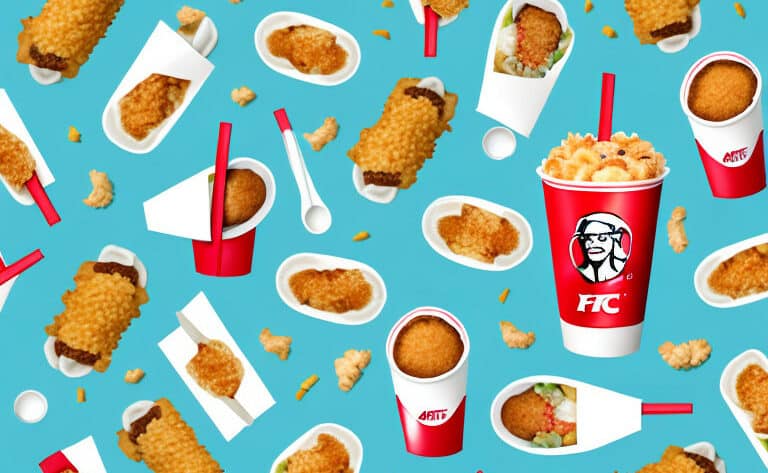If you’re trying to eat healthier, fast food joints can seem like the enemy. But what if we told you that you could enjoy a meal at KFC without feeling guilty about it? Yes, you read that right! KFC actually offers a variety of low-calorie options that won’t derail your diet. Let’s dig in and explore some of the best choices on the menu.
Understanding Low-Calorie Fast Food
Fast food has become a staple in our busy lives, but it’s important to make healthy choices when we indulge. One way to do this is by opting for low-calorie options. But what exactly does that mean? Let’s dive into the specifics.
In general, a meal that contains 500 calories or less is considered low in calories. This is an appropriate amount for most people who want to maintain a healthy weight and lifestyle. However, it’s important to note that not all calories are created equal. A low-calorie meal should be balanced and contain a mix of protein, complex carbs, and healthy fats.
Protein and fiber help you feel fuller for longer, which can prevent overeating and snacking on unhealthy foods later on. Carbs provide energy for your body, but it’s important to choose complex carbs like whole grains, which are digested more slowly and provide sustained energy. Fats are also important for your body, but you should aim for healthy fats like those found in nuts, seeds, and avocado, which can help you absorb nutrients and keep you feeling full.
What Constitutes a Low-Calorie Meal?
When it comes to fast food, it can be challenging to find low-calorie options that are also tasty and satisfying. However, many fast food chains are now offering healthier options on their menus. At KFC, for example, you can find grilled chicken options that are lower in calories and fat than their fried counterparts. You can also opt for a side salad instead of fries and choose water or unsweetened iced tea instead of soda.
When choosing a low-calorie meal, it’s important to pay attention to the nutrition information. Look for meals that contain less than 500 calories and are low in saturated and trans fats. You should also aim for meals that are high in protein and fiber to help you feel full and satisfied.
Health Benefits of Low-Calorie Options
Choosing low-calorie options has many health benefits. One of the most significant is weight loss. By reducing your calorie intake, you can create a calorie deficit, which can lead to weight loss over time. Low-calorie options can also help you maintain a healthy weight and prevent weight gain.
In addition to weight loss, choosing low-calorie options can also reduce your risk of heart disease. Eating a diet that is high in saturated and trans fats can increase your risk of heart disease, but choosing low-calorie options that are low in these fats can help protect your heart.
Finally, low-calorie options can also help improve blood sugar control. Eating a diet that is high in sugar and refined carbs can cause blood sugar spikes and crashes, which can lead to cravings and overeating. Choosing low-calorie options that are high in protein and fiber can help regulate blood sugar levels and prevent these spikes and crashes.
By choosing low-calorie options at KFC and other fast food chains, you can still enjoy your favorite fast food while taking care of your health. So next time you’re in a rush and need a quick meal, opt for a low-calorie option and feel good about your choice!
KFC’s Nutritional Information
When it comes to fast food, it’s important to know what you’re putting into your body. Luckily, KFC provides detailed nutritional information on their website, making it easier for you to make informed decisions about your food choices.
Before we get into the nitty-gritty of the menu, let’s talk about how to access KFC’s nutritional information. Simply visit www.kfc.com/nutrition to access the information you need.
Once you’ve accessed the website, you’ll find a breakdown of all the menu items, including calories, fat, sodium, carbs, and protein. This information can be incredibly useful for anyone looking to maintain a healthy diet or trying to lose weight.
It’s important to note that the serving sizes listed may not match the item you’re ordering. For example, a serving size for a chicken sandwich may be listed as one sandwich, but the sandwich you order may actually be a double or triple-decker. In these cases, it’s important to do some quick math to figure out how many calories and nutrients are in your specific meal.
Another thing to keep in mind is that sauces and dressings can add a significant amount of calories to your meal. For example, a serving of KFC’s honey mustard sauce adds an additional 70 calories to your meal. If you’re trying to watch your calorie intake, it’s a good idea to either skip the sauce or ask for it on the side so you can control the amount you’re consuming.
Decoding the Nutritional Facts
Now that you know how to access KFC’s nutritional information, let’s take a closer look at what it all means.
Calories are a measure of the energy provided by food. The number of calories you need each day depends on a variety of factors, including your age, gender, height, weight, and activity level. For most adults, the recommended daily calorie intake is between 1,500 and 2,000 calories.
Fat is an essential nutrient that provides energy and helps your body absorb vitamins. However, consuming too much fat can lead to weight gain and other health problems. The American Heart Association recommends that adults limit their daily intake of saturated fat to less than 13 grams per day.
Sodium is a mineral that helps regulate blood pressure and fluid balance in the body. However, consuming too much sodium can lead to high blood pressure and other health problems. The American Heart Association recommends that adults limit their daily intake of sodium to less than 2,300 milligrams per day.
Carbs are a source of energy for your body. There are two types of carbs: simple carbs, which are found in foods like sugar and candy, and complex carbs, which are found in foods like fruits, vegetables, and whole grains. It’s important to choose complex carbs over simple carbs, as they provide more nutrients and are digested more slowly, keeping you feeling full for longer.
Protein is an essential nutrient that helps build and repair tissues in your body. It’s important to consume enough protein in your diet, especially if you’re trying to build muscle or recover from an injury. The recommended daily intake of protein for adults is 0.8 grams per kilogram of body weight.
By understanding what each of these nutritional facts means, you can make informed decisions about what to order at KFC and how it fits into your overall diet.
Top Low-Calorie KFC Menu Items
Grilled Chicken Options
If you’re looking for a low-calorie protein source, grilled chicken is the way to go. KFC offers several options, including the Grilled Chicken Breast, which has only 220 calories and 7 grams of fat. You can also try the Grilled Chicken Thigh or Drumstick for a slightly higher calorie count, but still a healthy option.
Lighter Sandwich Choices
When it comes to sandwiches, KFC offers a variety of options that won’t break the calorie bank. The Crispy Colonel Sandwich contains 480 calories, while the Smoky Mountain BBQ Sandwich packs in 320 calories. If you’re looking for an even lighter option, try the Honey BBQ Sandwich, which has only 280 calories.
Sensible Sides and Salads
Who says you can’t enjoy sides and salads at a fast food restaurant? KFC has options like green beans, corn, and mashed potatoes that are all under 100 calories per serving. They also offer a variety of salads, including the Side Salad, Caesar Salad, and Crispy Chicken Caesar Salad. Just be sure to go easy on the dressing and opt for a lighter option like the Light Italian Dressing.
Low-Calorie Sauces and Dressings
If you’re a sauce lover, don’t worry! KFC has several low-calorie options that won’t ruin your meal. The Honey BBQ Dipping Sauce has only 45 calories per serving, while the Light Ranch Dressing has just 25 calories.
Customizing Your KFC Order
Of course, one of the best ways to ensure a low-calorie meal at KFC is to customize your order. Here are some tips:
Tips for Making Healthier Choices
- Ask for grilled chicken instead of fried
- Skip the bun or opt for a lettuce wrap
- Choose a side salad instead of fries
- Ask for extra veggies on your sandwich or bowl
- Go easy on the sauce and dressings
Swapping Ingredients for Lower-Calorie Options
If the idea of customizing your order sounds overwhelming, don’t worry! KFC has made it easy with their Build Your Own Bowl option. Simply choose a base of rice or lettuce, then add your protein, veggies, and sauce. This way, you can create a delicious, low-calorie meal that suits your tastes.
Maintaining a Balanced Diet While Eating Out at KFC
Portion Control and Mindful Eating
While it’s great to have low-calorie options at fast food restaurants, it’s important to remember that portion control and mindful eating are key to a healthy diet. You should aim to eat slowly, savoring each bite, and stopping when you’re full. Use smaller plates, bowls, and utensils to help control your portions.
Incorporating KFC’s Low-Calorie Options into Your Meal Plan
If you’re following a specific meal plan, you can still incorporate KFC’s low-calorie options into your diet. For example, you could have a Grilled Chicken Breast with a side of green beans and a Side Salad for a meal that’s low in calories and high in protein. The key is to make sure that you’re balancing your meals and choosing nutrient-dense foods whenever possible
As you can see, there are many low-calorie options available at KFC that won’t sabotage your healthy eating goals. Whether you’re in the mood for grilled chicken, a sandwich, or a salad, there’s something for everyone on the menu. By taking the time to customize your order and make mindful choices, you can enjoy a delicious, guilt-free meal at KFC.
*The information provided on this website is intended for general informational purposes only and should not be considered as medical advice. It is important to always consult with a qualified healthcare professional regarding any medical conditions, symptoms, or concerns you may have. This website does not provide medical diagnosis, treatment, or advice, and reliance on any information provided on this site is solely at your own risk.





